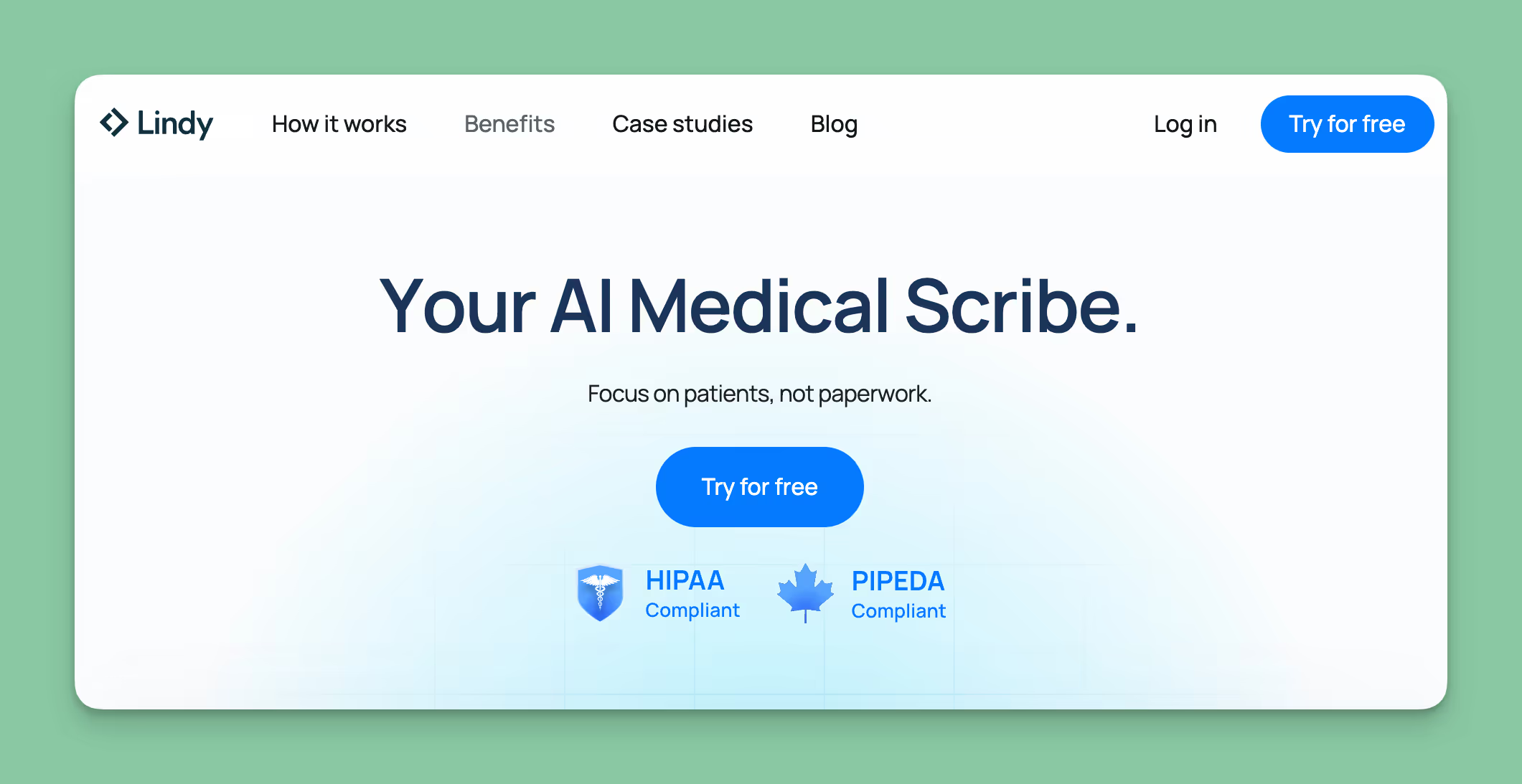SOAP notes may not look like much. After all, why do you have to scribble away all day? Isn’t it enough to just remember a session off the top of your head?
As it turns out, a chiropractor doctor's note is a systematic way for you to record each patient encounter in a standardized format used industry-wide.
Therefore, it’s essential to provide your patients with top-of-the-line care. But, you have to get it absolutely right!
In this article, we’ll walk you through:
- Chiropractor doctors note basics
- The SOAP acronym, what it means, and what it’s for.
- How to craft effective SOAP notes
- Two clear examples of clear, though-out SOAP notes
- And, finally, the different ways to take down notes – including a fascinating high-tech solution
Let’s dive right in!

What is a chiropractors doctors note?
A chiropractic doctors note, or SOAP note provides a written record of your appointment and treatment plan.
It’s a detailed way to keep track of everything that happens in a session, from the patient’s ailments to their history with their illness, your proposed solutions, and ongoing response to treatments.
These records are also known as chiropractic SOAP notes, are very important for keeping track of a patient’s progress – and making sure you get paid for the services you’ve provided.
Simply put, without SOAP notes entered into some form of Electronic Health Record (EHR), there’d be no way to account for what happened in a session other than memory and hearsay.
What do SOAP notes include?
There are four sections in these notes:
- Subjective: The information and feedback you receive from patients regarding their symptoms, pain levels, and limitations.
- Objective: Your observations and findings during patient examination, including assessments of range of motion, posture, and palpation results.
- Assessment: Your diagnosis and clinical impression of the patient's condition, which are derived from both subjective feedback and objective observations.
- Plan: Your recommended course of treatment for the patient, encompassing adjustments, prescribed exercises, suggested lifestyle changes, and any additional recommendations.
Here’s a very short example of what one of these chiropractor doctor notes may look like:
S: Patient complains of lower back pain (LBP) that radiates into the left leg. Pain is worse when sitting and bending forward. Rates pain 7/10.
O: Lumbar range of motion limited by 30%. Tenderness over L4-L5 region. Positive straight leg raise test on left.
A: Acute exacerbation of chronic L4-L5 disk bulge with sciatica.
P: Adjust L4-L5, side posture. Ice 20 minutes 3x/day. Return in 2 days. Avoid prolonged sitting.
Now, while SOAP notes do require time to complete (clinicians spend 4.5 hours per day on them), tools like Lindy can help optimize the process.
How do you create effective chiropractor doctors notes?
The best way is to go section by section, demystifying each part.
For the Subjective section, document your patient’s symptoms and medical history in their own words.
Try to ask open-ended questions to get details about the severity and duration of their pain or discomfort. Don’t judge, just listen and try to assess what’s going on.
The Objective section focuses on your clinical findings. Note the results of any physical exams, tests, or imaging performed. Describe the patient’s posture, range of motion, and any areas of concern.
In the Assessment stage, analyze the subjective and objective information to determine a diagnosis. Explain your clinical impression of the patient’s condition and the underlying cause of their symptoms.
Finally, it’s time to outline the Plan for treatment and management. This may include chiropractic adjustments (can you say “crack?”), soft tissue work, rehab exercises, lifestyle changes, etc. Be detailed when talking about the frequency and duration of treatment.
Two examples of chiropractic SOAP notes
These two chiropractor doctor's notes will help you have a set template to follow.
Pay attention:
Example #1: Patient with severe neck pain
Subjective: Ms. Daisy Buchanan (48F) presented with a primary complaint of neck pain radiating down her right shoulder and arm. Pain started 2 weeks ago after lifting a heavy potted plant.
Describes pain as sharp, aching, and worse with overhead activities and sleeping on her right side. Also reports occasional headaches and dizziness. No history of trauma or recent falls.
Objective: Initial examination revealed postural misalignment with rounded shoulders and forward head posture. Active range of motion in the cervical spine was restricted, particularly in right rotation and side bending.
Tenderness to palpation at the C4-C5 and C5-C6 vertebral levels. Positive Spurling's test on the right side, suggests nerve root irritation.
Assessment: Acute mechanical neck pain with cervical muscle strain and possible nerve root compression at C5-C6. Postural dysfunction likely contributing to the issue.
Plan: Recommend chiropractic adjustments focusing on the cervical spine, specifically C4-C6. Prescribe ice and heat therapy along with gentle stretching exercises.
Advise ergonomic modifications at work and home to address postural imbalances. Schedule follow-up appointments in 1 week to assess progress.
Addendum: Patient is apprehensive due to previous negative experiences with chiropractic care. Emphasized gentle approach and addressed her concerns to build trust and encourage adherence to the treatment plan.
Example #2: Juan’s back pain
Subjective: Mr. Juan Galvez (55M) returned for his second follow-up appointment. Reports significant improvement in back pain since starting chiropractic care.
Pain intensity has decreased from 8/10 to 4/10. Range of motion has significantly improved, and he is able to participate in his usual physical activities with minimal discomfort. Still experiences occasional stiffness in the mornings, but it resolves quickly with movement.
Objective: Reassessment showed improved posture and increased flexibility in the lumbar spine. Tenderness to palpation has significantly reduced but lingers slightly at L4-L5. Range of motion tests within normal limits, except for slight limitation in forward flexion.
Assessment: Positive response to chiropractic treatment. Continued adjustments are warranted to further stabilize the spine and address residual stiffness.
Plan: Recommend continued chiropractic adjustments with reduced frequency. Encourage regular stretching and core strengthening exercises to maintain progress. Schedule next appointment in 4 weeks for monitoring and potential discharge from active care.
Addendum: Patient is highly motivated and compliant with the treatment plan. Discuss preventative measures to minimize future episodes and promote long-term spinal health.
How to avoid SOAP notes taking up most of your day
To optimize your time spent on SOAP notes, there are a few tips and tricks you can use. As a chiropractor, you know how much time can be eaten up with note-taking if you’re not on the ball.
Follow a template
Having a template for your SOAP notes, whether digital like this one or paper, can save you time. Use a template that has clear sections for each part of the SOAP note. We may be biased, but we do recommend our template above!
Inside each section, have standard questions or areas you always address. This provides consistency.
Computer-savvy? Use macros!
If your EHR system offers the ability to create macros or shortcuts, take advantage of the opportunity.
Macros allow you to input a short code that will automatically expand into a full response. For example, you could try setting up a macro “ROM WNL” that expands into “Range of motion within normal limits for cervical spine in all planes with no pain reported.”
This way you only have to type a few letters rather than the full response each time. You will still have to memorize your macros, of course.
Or - Just use an AI Medical Scribe like Lindy!

Lindy is an AI Medical Scribe which specializes in dictation and transcription and can help speed up your SOAP note process. It uses natural language processing to take the information you provide and automatically populate it into a SOAP note template.
Then, you simply speak or type in details from your patient encounter and Lindy converts it into a proper SOAP note, which you can then review and modify as needed before Lindy uploads it to your EHR system itself, with full HIPAA compliance.
Overall, note-taking takes out a huge chunk of your day (4.5 hours on average). Lindy is helping clinicians get two of those hours back each day, hours which they use to engage with their patients and provide excellent service.
Optimize your note-taking
The more detailed notes you take during a patient visit, the less time you'll spend afterwards trying to recall specifics to include in the SOAP note.
So, write down the patient's subjective symptoms, your objective findings, assessments, and recommended plan of care. Then, you can transfer those records into the “official” SOAP note, and then the EHR.
Summing up
Now you have some templates to start becoming proficient in SOAP writing during your chiropractic practice.
As we said, these “chiropractor doctors notes” may not seem like much at first glance, and they may be tedious at times, but they’re important for establishing a consistent system for documenting patient care.
And yes, AI assistants can help you alleviate some of that workload, and leave you time to focus on the things that matter most: your patients and your practice.
FAQs
What's the content of a chiropractor doctors note?
A SOAP note (Subjective, Objective, Assessment, Plan) note helps you map your treatment. It captures the patient’s injury details, symptoms, the adjustments or techniques used, their body's response, specific tests done, and the chiropractor’s interpretation of it all. The patient shares their data, the chiropractor analyzes it and helps chart a plan for recovery
When does note-taking happen?
While jotting down key points during a session is OK, full-fledged note-taking can feel intrusive and take away from your precious face-to-face time. That's why most chiropractors choose to document their observations and insights soon after an appointment. Of course, waiting too long can lead to memory blanks, so striking a balance is key.
How long should chiropractor doctors notes be?
There's no one-size-fits-all prescription for note length. The idea is to provide just enough detail to capture the essence without getting bogged down in unnecessary details. Ideally, strive for 1-2 pages that paint a clear picture of a session without becoming a novel.
Do chiropractor notes hold legal weight?
Yes, chiropractor’s notes can support insurance claims, personal injury cases, or worker's compensation claims. However, their specific weight and acceptance hinge on various factors like the judge or legal system involved. Check with your lawyer for specific concerns.
Can you use a chiropractor's note to get out of work or school?
Chiropractor doctors notes can excuse you from work or school activities depending on the severity of your condition and limitations outlined in the note. However, each company or institution has its policies and procedures for handling these notes.













.jpg)
.png)
.png)


.png)
.png)